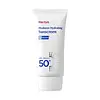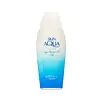What's inside
What's inside
 Key Ingredients
Key Ingredients

 Benefits
Benefits

 Concerns
Concerns

 Ingredients Side-by-side
Ingredients Side-by-side

Water
Skin ConditioningDibutyl Adipate
EmollientPropanediol
SolventEthylhexyl Triazone
UV AbsorberPolymethylsilsesquioxane
Diethylamino Hydroxybenzoyl Hexyl Benzoate
UV FilterMethylene Bis-Benzotriazolyl Tetramethylbutylphenol
UV FilterDrometrizole Trisiloxane
UV AbsorberNiacinamide
SmoothingCoco-Caprylate/Caprate
EmollientCaprylyl Methicone
Skin ConditioningGlycerin
Humectant1,2-Hexanediol
Skin ConditioningButylene Glycol
HumectantPentylene Glycol
Skin ConditioningBehenyl Alcohol
EmollientPoly C10-30 Alkyl Acrylate
Emulsion StabilisingVp/Eicosene Copolymer
Polyglyceryl-3 Methylglucose Distearate
EmulsifyingDecyl Glucoside
CleansingTromethamine
BufferingParfum
MaskingCarbomer
Emulsion StabilisingAcrylates/C10-30 Alkyl Acrylate Crosspolymer
Emulsion StabilisingSodium Stearoyl Glutamate
CleansingPolyacrylate Crosspolymer-6
Emulsion StabilisingEthylhexylglycerin
Skin ConditioningAdenosine
Skin ConditioningDioscorea Japonica Root Extract
Skin ConditioningUlmus Davidiana Root Extract
Skin ConditioningAloe Barbadensis Leaf Extract
EmollientLaminaria Japonica Extract
Skin ProtectingViola Mandshurica Flower Extract
AntioxidantXanthan Gum
EmulsifyingHydrolyzed Hyaluronic Acid
HumectantTocopherol
AntioxidantPanthenol
Skin ConditioningSqualene
EmollientHydrogenated Lecithin
EmulsifyingCentella Asiatica Extract
CleansingFicus Carica Fruit Extract
HumectantCamellia Sinensis Leaf Extract
AntimicrobialGinkgo Biloba Leaf Extract
Skin ConditioningTriticum Vulgare Sprout Extract
Skin ConditioningCamellia Japonica Leaf Extract
Skin ConditioningBrassica Oleracea Italica Sprout Extract
EmollientMedicago Sativa Extract
TonicEruca Sativa Leaf Extract
Skin ConditioningCeramide NP
Skin ConditioningHydrangea Macrophylla Leaf Extract
Skin ConditioningBambusa Vulgaris Shoot Extract
AntioxidantBambusa Vulgaris Leaf/Stem Extract
HumectantBambusa Vulgaris Water
Skin ConditioningDimethylsilanol Hyaluronate
HumectantHydrolyzed Sodium Hyaluronate
Skin ConditioningPotassium Hyaluronate
Skin ConditioningHyaluronic Acid
HumectantSodium Hyaluronate
HumectantSodium Hyaluronate Crosspolymer
HumectantHydroxypropyltrimonium Hyaluronate
Sodium Hyaluronate Dimethylsilanol
HumectantSodium Acetylated Hyaluronate
HumectantWater, Dibutyl Adipate, Propanediol, Ethylhexyl Triazone, Polymethylsilsesquioxane, Diethylamino Hydroxybenzoyl Hexyl Benzoate, Methylene Bis-Benzotriazolyl Tetramethylbutylphenol, Drometrizole Trisiloxane, Niacinamide, Coco-Caprylate/Caprate, Caprylyl Methicone, Glycerin, 1,2-Hexanediol, Butylene Glycol, Pentylene Glycol, Behenyl Alcohol, Poly C10-30 Alkyl Acrylate, Vp/Eicosene Copolymer, Polyglyceryl-3 Methylglucose Distearate, Decyl Glucoside, Tromethamine, Parfum, Carbomer, Acrylates/C10-30 Alkyl Acrylate Crosspolymer, Sodium Stearoyl Glutamate, Polyacrylate Crosspolymer-6, Ethylhexylglycerin, Adenosine, Dioscorea Japonica Root Extract, Ulmus Davidiana Root Extract, Aloe Barbadensis Leaf Extract, Laminaria Japonica Extract, Viola Mandshurica Flower Extract, Xanthan Gum, Hydrolyzed Hyaluronic Acid, Tocopherol, Panthenol, Squalene, Hydrogenated Lecithin, Centella Asiatica Extract, Ficus Carica Fruit Extract, Camellia Sinensis Leaf Extract, Ginkgo Biloba Leaf Extract, Triticum Vulgare Sprout Extract, Camellia Japonica Leaf Extract, Brassica Oleracea Italica Sprout Extract, Medicago Sativa Extract, Eruca Sativa Leaf Extract, Ceramide NP, Hydrangea Macrophylla Leaf Extract, Bambusa Vulgaris Shoot Extract, Bambusa Vulgaris Leaf/Stem Extract, Bambusa Vulgaris Water, Dimethylsilanol Hyaluronate, Hydrolyzed Sodium Hyaluronate, Potassium Hyaluronate, Hyaluronic Acid, Sodium Hyaluronate, Sodium Hyaluronate Crosspolymer, Hydroxypropyltrimonium Hyaluronate, Sodium Hyaluronate Dimethylsilanol, Sodium Acetylated Hyaluronate
Water
Skin ConditioningEthylhexyl Methoxycinnamate
UV AbsorberAlcohol
AntimicrobialButylene Glycol
HumectantIsononyl Isononanoate
EmollientDiethylamino Hydroxybenzoyl Hexyl Benzoate
UV FilterEthylhexyl Triazone
UV AbsorberBis-Ethylhexyloxyphenol Methoxyphenyl Triazine
Skin ConditioningPolyglyceryl-10 Pentaisostearate
EmollientPhenoxyethanol
PreservativeAcrylates/C10-30 Alkyl Acrylate Crosspolymer
Emulsion StabilisingTriethanolamine
BufferingBis-PEG-18 Methyl Ether Dimethyl Silane
EmollientDisodium EDTA
Xanthan Gum
EmulsifyingSilica
AbrasiveDiethoxyethyl Succinate
SolventHydrolyzed Sodium Hyaluronate
Skin ConditioningSodium Hyaluronate
HumectantHydroxypropyltrimonium Hyaluronate
Water, Ethylhexyl Methoxycinnamate, Alcohol, Butylene Glycol, Isononyl Isononanoate, Diethylamino Hydroxybenzoyl Hexyl Benzoate, Ethylhexyl Triazone, Bis-Ethylhexyloxyphenol Methoxyphenyl Triazine, Polyglyceryl-10 Pentaisostearate, Phenoxyethanol, Acrylates/C10-30 Alkyl Acrylate Crosspolymer, Triethanolamine, Bis-PEG-18 Methyl Ether Dimethyl Silane, Disodium EDTA, Xanthan Gum, Silica, Diethoxyethyl Succinate, Hydrolyzed Sodium Hyaluronate, Sodium Hyaluronate, Hydroxypropyltrimonium Hyaluronate
 Reviews
Reviews

Ingredients Explained
These ingredients are found in both products.
Ingredients higher up in an ingredient list are typically present in a larger amount.
Acrylates/C10-30 Alkyl Acrylate Crosspolymer is a synthetic polymer. It is used to thicken and improve the texture of products. Due to its properties, it can prevent water and oil ingredients from separating.
Butylene Glycol (or BG) is used within cosmetic products for a few different reasons:
Overall, Butylene Glycol is a safe and well-rounded ingredient that works well with other ingredients.
Though this ingredient works well with most skin types, some people with sensitive skin may experience a reaction such as allergic rashes, closed comedones, or itchiness.
Learn more about Butylene GlycolDiethylamino Hydroxybenzoyl Hexyl Benzoate (DHHB) is a chemical UV-A absorber. It is formulated for high UVA protection (320-400 nm).
DHHB is well-liked for:
DHHB has been approved by the EU, Japan, Taiwan, and South America for use up to 10%. Unfortunately, it has not been approved for use in the US or Canada due to slow regulatory processes.
This ingredient is soluble in oils, fats, and lipids.
Learn more about Diethylamino Hydroxybenzoyl Hexyl BenzoateEthylhexyl Triazone is a modern chemical sunscreen that protects from UV-B radiation.
It is the most effective of existing UV-B filters, as it provides the highest level of photo-stable absorption. It protects from the entire UV-B range (280 to 320nm), with it's highest level of protection at 314nm.
Ethylhexyl Triazone is oil soluble, oderless and colorless, which mean it is able to be incorporated into a variety of different formulations.
It is not currently available within the United States due to slow changing FDA regulations. Outside of the US, it is used in formulations at concentrations up to 5%.
Learn more about Ethylhexyl TriazoneThis ingredient is created by putting sodium hyaluronate through hydrolysis.
You might know this as 'mini' or 'ultra low-molecular weight' hyaluronic acid. The small molecule size means it is able to travel deeper in the skin.
According to studies, low molecular-weight hyaluronic acid can:
One study from 2011 found ultra-low weight HA to show pro-inflammatory properties. Another study from 2022 found it to downregulate UV-B induced inflammation.
Hydrolysis is a process of changing a molecule using water or enzymes.
This ingredient is water-soluble.
Learn more about Hydrolyzed Sodium HyaluronateThis form of hyaluronic acid is produced through fermentation.
According to a manufacturer, it has a positive charge by ionic binding to help moisturize and give hair a smooth feel. This is why you'll find this ingredient in shampoos and body washes.
Sodium Hyaluronate is hyaluronic acid's salt form. It is commonly derived from the sodium salt of hyaluronic acid.
Like hyaluronic acid, it is great at holding water and acts as a humectant. This makes it a great skin hydrating ingredient.
Sodium Hyaluronate is naturally occurring in our bodies and is mostly found in eye fluid and joints.
These are some other common types of Hyaluronic Acid:
Learn more about Sodium HyaluronateWater. It's the most common cosmetic ingredient of all. You'll usually see it at the top of ingredient lists, meaning that it makes up the largest part of the product.
So why is it so popular? Water most often acts as a solvent - this means that it helps dissolve other ingredients into the formulation.
You'll also recognize water as that liquid we all need to stay alive. If you see this, drink a glass of water. Stay hydrated!
Learn more about WaterXanthan gum is used as a stabilizer and thickener within cosmetic products. It helps give products a sticky, thick feeling - preventing them from being too runny.
On the technical side of things, xanthan gum is a polysaccharide - a combination consisting of multiple sugar molecules bonded together.
Xanthan gum is a pretty common and great ingredient. It is a natural, non-toxic, non-irritating ingredient that is also commonly used in food products.
Learn more about Xanthan Gum